[BZOJ1576] [BZOJ3694] [USACO2009Jan] 安全路径(最短路径+树链剖分)
[BZOJ1576] [BZOJ3694] [USACO2009Jan] 安全路径(最短路径+树链剖分)
题面
BZOJ1576和BZOJ3694几乎一模一样,只是BZOJ3694直接给出了最短路树
给出一个n个点m条边的无向图,n个点的编号从1~n,定义源点为1。定义最短路树如下:从源点1经过边集T到任意一点i有且仅有一条路径,且这条路径是整个图1到i的最短路径,边集T构成最短路树。 给出最短路树,求对于除了源点1外的每个点i,求最短路,要求不经过给出的最短路树上的1到i的路径的最后一条边。
分析
求最短路树的过程略。
删掉了树上一个点i到父亲的边(即1到i路径上最后一条边)后,我们必须经过非树边才能到达i。贪心考虑,只经过一条非树边显然是最优的。

对于一条非树边(x,y) [图中蓝色虚线],它在树上对应一条路径(x,y).对于这条路径上的点z,在z往它父亲的边被删除后,我们可以走这样的路径1->x->y->z。1->x的距离显然为\(dist(x)\),x->y的距离为\(len(x,y)\),y->z的距离[绿线]是\(dist[y]-dist[z]\).因此到z的路径长度就是\(dist[x]+dist[y]+len(x,y)-dist[z]\)
注意到当z=lca(x,y)时,是不能从1->x->y->z的,因为z到父亲的边被删除后无法到达x.
那么方法就很明确了。对于每条边,我们用\(dist[x]+dist[y]+len(x,y)\)去更新路径(x,y)(不包含lca)上的点,每个点\(z\)求出\(min(dist[x]+dist[y]+len(x,y))\)。最后输出\(min(dist[x]+dist[y]+len(x,y))-dist[z]\)即可。路径修改,单点查询,可以用树链剖分解决。时间复杂度\(O(n \log^2 n)\)
代码
#include<iostream>
#include<cstdio>
#include<cstring>
#include<algorithm>
#include<queue>
#include<vector>
#define maxn 4000
#define maxm 100000
#define INF 0x3f3f3f3f3f3f3f3f
using namespace std;
typedef long long ll;
int n,m;
struct edge{
int from;
int to;
int next;
int len;
int type;
}E[maxm*2+5];
int head[maxn+5];
int esz=1;
void add_edge(int u,int v,int w,int t){
esz++;
E[esz].from=u;
E[esz].to=v;
E[esz].next=head[u];
E[esz].len=w;
E[esz].type=t;
head[u]=esz;
}
struct node{
int id;
ll dist;
node(){
}
node(int _id,ll _dist){
id=_id;
dist=_dist;
}
friend bool operator < (node p,node q){
return p.dist>q.dist;
}
};
bool vis[maxn+5];
ll dist[maxn+5];
void dijkstra(int s){
priority_queue<node>q;
memset(vis,0,sizeof(vis));
memset(dist,0x3f,sizeof(dist));
dist[s]=0;
q.push(node(s,0));
while(!q.empty()){
int x=q.top().id;
q.pop();
if(vis[x]) continue;
vis[x]=1;
for(int i=head[x];i;i=E[i].next){
int y=E[i].to;
if(dist[y]>dist[x]+E[i].len){
dist[y]=dist[x]+E[i].len;
if(!vis[y]) q.push(node(y,dist[y]));
}
}
}
}
vector<int>T[maxn+5];
int deep[maxn+5];
int sz[maxn+5];
int fa[maxn+5];
int son[maxn+5];
int top[maxn+5];
int dfn[maxn+5];
int tim;
void dfs1(int x,int f){
sz[x]=1;
fa[x]=f;
deep[x]=deep[f]+1;
for(int i=0;i<T[x].size();i++){
int y=T[x][i];
if(y!=f){
dfs1(y,x);
sz[x]+=sz[y];
if(sz[y]>sz[son[x]]) son[x]=y;
}
}
}
void dfs2(int x,int t){
top[x]=t;
dfn[x]=++tim;
if(son[x]) dfs2(son[x],t);
for(int i=0;i<T[x].size();i++){
int y=T[x][i];
if(y!=fa[x]&&y!=son[x]){
dfs2(y,y);
}
}
}
struct segment_tree{
struct node{
int l;
int r;
ll val;
ll mark;
}tree[maxn*4+5];
void push_up(int pos){
tree[pos].val=max(tree[pos<<1].val,tree[pos<<1|1].val);
}
void build(int l,int r,int pos){
tree[pos].l=l;
tree[pos].r=r;
tree[pos].mark=INF;
tree[pos].val=INF;
if(l==r) return;
int mid=(l+r)>>1;
build(l,mid,pos<<1);
build(mid+1,r,pos<<1|1);
push_up(pos);
}
void push_down(int pos){
if(tree[pos].mark!=INF){
tree[pos<<1].mark=min(tree[pos<<1].mark,tree[pos].mark);
tree[pos<<1|1].mark=min(tree[pos<<1|1].mark,tree[pos].mark);
tree[pos<<1].val=min(tree[pos<<1].val,tree[pos].mark);
tree[pos<<1|1].val=min(tree[pos<<1|1].val,tree[pos].mark);
tree[pos].mark=INF;
}
}
void update(int L,int R,ll uval,int pos){
if(L<=tree[pos].l&&R>=tree[pos].r){
tree[pos].mark=min(tree[pos].mark,uval);
tree[pos].val=min(tree[pos].val,uval);
return;
}
push_down(pos);
int mid=(tree[pos].l+tree[pos].r)>>1;
if(L<=mid) update(L,R,uval,pos<<1);
if(R>mid) update(L,R,uval,pos<<1|1);
push_up(pos);
}
ll query(int L,int R,int pos){
if(L<=tree[pos].l&&R>=tree[pos].r){
return tree[pos].val;
}
push_down(pos);
int mid=(tree[pos].l+tree[pos].r)>>1;
ll ans=INF;
if(L<=mid) ans=min(ans,query(L,R,pos<<1));
if(R>mid) ans=min(ans,query(L,R,pos<<1|1));
return ans;
}
}S;
int lca(int x,int y){
while(top[x]!=top[y]){
if(deep[top[x]]<deep[top[y]]) swap(x,y);
x=fa[top[x]];
}
if(deep[x]>deep[y]) swap(x,y);
return x;
}
void update(int x,int y,ll val){
// printf("update %d->%d val=%d\n",x,y,val);
int tx=top[x],ty=top[y];
while(tx!=ty){
if(deep[tx]<deep[ty]){
swap(tx,ty);
swap(x,y);
}
S.update(dfn[tx],dfn[x],val,1);
x=fa[tx];
tx=top[x];
}
if(deep[x]>deep[y]) swap(x,y);
S.update(dfn[son[x]],dfn[y],val,1);//注意是son[x]而不是x,因为不包含lca
}
int main(){
int u,v,w,t;
scanf("%d %d",&n,&m);
for(int i=1;i<=m;i++){
scanf("%d %d %d %d",&u,&v,&w,&t);
add_edge(u,v,w,t);
add_edge(v,u,w,t);
if(t==1){
T[u].push_back(v);
T[v].push_back(u);
}
}
dijkstra(1);
dfs1(1,0);
dfs2(1,0);
S.build(1,n,1);
for(int i=2;i<=esz;i+=2){
if(E[i].type==0){
int x=E[i].from;
int y=E[i].to;
update(x,y,dist[x]+dist[y]+E[i].len);
}
}
for(int i=2;i<=n;i++){
ll ans=S.query(dfn[i],dfn[i],1);
if(ans==INF) printf("-1 ");
else printf("%lld ",ans-dist[i]);
}
}
版权声明:因为我是蒟蒻,所以请大佬和神犇们不要转载(有坑)的文章,并指出问题,谢谢


 浙公网安备 33010602011771号
浙公网安备 33010602011771号